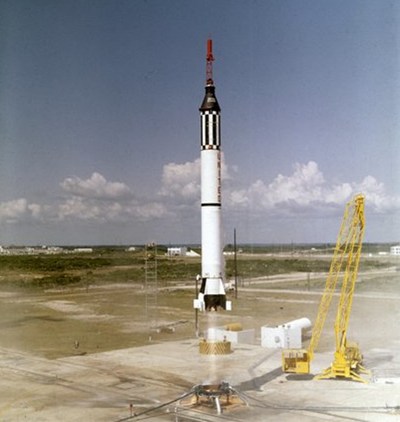Old Reliable: The story of the Redstoneby Andrew J. LePage
|
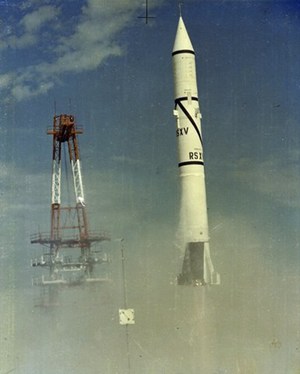 The launch of the first Redstone from Cape Canaveral on August 20, 1953. (credit: NASA/MSFC) |
The origins of the Redstone
After the end of World War II, the core of the team led by Wernher von Braun that developed and built the German A-4 missile (also popularly known as the V-2) were relocated to the United States to begin ballistic missile development for the US Army. What would become the Redstone started as a design study called Hermes C in the late 1940s. The Hermes program was a series of experimental rockets that combined proven German A-4 technology with new American innovations. As such, the Redstone is a direct descendant of the A-4. In July 1950, a feasibility study began for a ballistic missile with an 800-kilometer (500-mile) range based on the Hermes C work.
| The Redstone is a direct descendant of the A-4, better known as the V-2. |
As the war in Korea dragged on, the program received the highest “1A” priority and was redirected in the hopes of employing it in that conflict. In order to speed development and make it a mobile field weapon, the nominal range was reduced to 320 kilometers (200 miles) and it was decided to use a smaller engine built by North American Aviation (later, by their Rocketdyne division) based on the one used by the Navaho cruise missile’s rocket booster. On April 8, 1952, this new tactical missile was officially named Redstone after the Redstone Arsenal in Huntsville, Alabama, where Dr. von Braun and his team had moved in 1950.
The single-stage Redstone with its warhead attached was originally 19.2 meters (63 feet) long and 1.78 meters (70 inches) in diameter. Later production models had a length of 21.0 meters (69 feet) and a weighed as much as 28,000 kilograms (62,000 pounds) at launch depending on its payload. Its A-7 engine generated 334 kilonewtons (75,000 pounds-force) of thrust for 110 seconds burning the same combination of propellants used by the A-4 rocket: liquid oxygen and a mixture of 75% ethanol and 25% water. The Redstone was controlled by an inertial guidance system and was steered during powered flight using moveable vanes in the A-7 engine’s exhaust stream as well as movable rudders on the tips of the four stabilizing fins at the base of the rocket; a system similar to that employed by the German A-4 rocket. The first 16 Redstone rockets were built at the Redstone Arsenal with subsequent missiles manufactured under contract by Chrysler at its facility in Sterling Heights, Michigan.
Like the A-4, the Redstone could carry a warhead containing high explosives. To significantly increase the destructive power of the Redstone, it was also designed to carry a W-39 nuclear warhead. The W-39 was originally developed for the Snark intercontinental-range cruise missile. Weighing 3,100 kilograms (6,900 pounds), the W-39 had a yield of 2.5 megatons, or over one hundred times greater than the nuclear bomb dropped on Hiroshima. Early in the development of the Redstone engineers realized that the range and accuracy would be improved if the warhead separated from the Redstone after burnout, unlike the A-4, where the warhead remained attached throughout its flight. The W-39 was housed in a tapered cylinder topped with a nosecone that was 11.4 meters (37.4 feet) long with the Redstone’s instrument compartment attached. The warhead was guided to its target after separation using four air vanes at its base. The Redstone could deliver its nuclear cargo to a point 240 kilometers (150 miles) away with an accuracy of 140 meters (150 yards).
Development of the Redstone proceeded quickly and the first test flight was launched from Cape Canaveral on August 20, 1953. While this first flight was less than successful, the design quickly proved itself during the succeeding three dozen tests flown over the next five years. After the first 11 test flights that were exclusively for Redstone development, subsequent flights starting in March 1956 also tested the guidance system and other components for the new Jupiter IRBM (Intermediate Range Ballistic Missile), which was also being developed for the Army by Dr. von Braun and his team in Huntsville. This version of the Redstone, called Jupiter A, also tested various upgrades to the Redstone design as well as ground equipment to help gain additional practical experience with the rocket.
In April 1956, the Army’s first Redstone battalion was formed. In February 1958, Army crews began training flights with actual Redstones launched from Cape Canaveral and White Sands. The Redstone became operational on June 1, 1958, and was subsequently deployed in Europe to support NATO’s shield force on what was then the front lines of the Cold War. The Redstone became the first large ballistic missile deployed overseas by the United States.
Not long after entering service, two Redstones were launched from Johnson Island in the Pacific Ocean as part of Operation Hardtack. Started in 1952 by the Atomic Energy Commission, the purpose of Operation Hardtack was to determine the effects of high altitude nuclear detonations. The first Redstone launch on July 31, 1958, code named “Teak”, lofted its W-39 warhead to an altitude of 76.8 kilometers (47.7 miles) where it was detonated. The test created a fireball 18 kilometers (11 miles) in diameter that could be seen from the Hawaii 1,300 kilometers (800 miles) away. The explosion blacked out short wave radio over the Pacific for up to nine hours and generated an aurora that was observed from the Samoan Islands 3,200 kilometers (2,000 miles) away. The second launch on August 11, code named “Orange”, sent its warhead to an altitude of 43.0 kilometers (26.7 miles) before detonating. In the process of supporting the goals of Operation Hardtack, the Redstone had now received a complete end-to-end test in the field from launch to the detonation of its nuclear warhead.
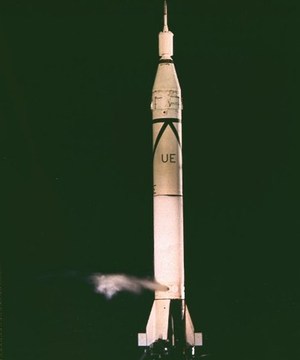 The Redstone-based Juno I rocket before it launched Explorer 1 into orbit on January 31, 1958. (credit: NASA/MSFC) |
The Redstone in the Space Age
While Dr. von Braun and his team were developing the Redstone and later the Jupiter for use as weapons, their real dream of spaceflight was never far from their minds. During the early stages of its development, they realized that a modified Redstone could serve as the basis of a launch vehicle capable of orbiting a miniaturized satellite payload. Eventually a joint Army-Navy study was started called Project Orbiter. In its original incarnation, the Redstone would loft a “high speed assembly” consisting of cluster of 37 Loki surface-to-air missiles that would fire at altitude to send a small satellite into orbit.
| While Dr. von Braun and his team were developing the Redstone and later the Jupiter for use as weapons, their real dream of spaceflight was never far from their minds. |
The proposal was submitted to the Department of Defense in September 1954. On September 9, 1955, the DoD rejected that plan in favor of a proposal by the Naval Research Laboratory to use modified versions of their Viking and Aerobee sounding rockets to orbit a satellite. Eventually called Vanguard, this was to be America’s “official” satellite program, which hoped to orbit a payload during the International Geophysical Year in 1957–58.
Undeterred, Dr. von Braun and his team continued to develop and improve upon the original Project Orbiter proposal in hopes of being given approval to launch a satellite before Vanguard. In its final incarnation, a modified version of the Redstone was employed as the first stage of the launch vehicle. While the diameter of the missile remained unchanged, the propellant tanks of the production Redstone were lengthened by 1.65 meters (5 feet 5 inches) to increase the burn time to 155 seconds. The A-7 engine was modified to use what the Army called Hydyne as a fuel to generate 369 kilonewtons (83,000 pounds-force) of thrust. Hydyne consisted of a corrosive mixture of 60% unsymmetrical dimethylhydrazine (UDMH) and 40% diethylene triamine (DET) that packed more of a punch than the ethanol normally used by the Redstone.
Mounted on top of this modified Redstone was a cluster of 15 scaled-down versions of the JPL-developed rocket motor used in the Sergeant surface-to-surface tactical missiles. Eleven of these motors were used as the second stage, three in the third stage, and a single motor as the fourth stage. This Redstone-based launch vehicle had a total length of 21.7 meters (71 feet 3 inches) and a lift off weight of 29,000 kilograms (64,000 pounds). It was capable of orbiting 11 kilograms (25 pounds).
While the Army was banned from developing this rocket as a satellite launcher, Dr. von Braun’s rocket did have an application in support of the Jupiter IRBM development effort. One of the unresolved issues for an IRBM was the survival of its warhead after a high-speed reentry into Earth’s atmosphere. While the proposed satellite launcher was not powerful enough to loft an actual Jupiter warhead, the rocket was capable of accelerating a one-third scale model weighing 140 kilograms (300 pounds) to hypersonic velocities to test the design. The only major change required was the removal of the final stage and the installation of an adapter for the nosecone. The development of this rocket, now designated Jupiter C ("C" standing for "Composite") to help disguise its heritage under the Jupiter program umbrella, proceeded so that the satellite launch option would be preserved.
The first launch of the Jupiter C went off without a hitch on September 20, 1956. The inert fourth stage and its dummy satellite payload reached a record peak altitude of 1,097 kilometers (682 miles) and landed 5,366 kilometers (3,335 miles) downrange in the Atlantic Ocean. The principle objectives of the flight were met and the beacon on the simulated satellite payload was tracked throughout the flight. Von Braun and his team had demonstrated that they had the means of launching a satellite into orbit.
On May 15, 1957, the second Jupiter C, which was the first to carry a scaled Jupiter IRBM nosecone payload, successfully lifted off. Although the rocket operated as intended, a guidance system malfunction caused the nosecone to overshoot the target area and the payload was not recovered. Radar tracking, however, indicated that the test vehicle’s ablative heat shield worked as intended and that the nosecone survived reentry. The third flight of the Jupiter C took place on August 8, 1957. The nosecone was quickly recovered and within days presented by President Eisenhower on national television as the first object to be successfully recovered from space. With this successful third flight, the Jupiter C program had met all of its objectives and the program was declared completed. The remaining Jupiter C rockets were placed into storage in hopes of using them to launch a satellite.
| Being the first large missile developed in the United States, it laid the groundwork for subsequent advances in American missile technology. |
The Jupiter C did not have to wait long. On October 4, 1957 the Soviet Union launched Sputnik. Five days after the launch of Sputnik 2 on November 3, Dr. von Braun and his team at Huntsville were given official approval to attempt a satellite launch using a four-stage version of the Jupiter C now called the Juno I. After the spectacular failure of Vanguard TV-3 on its first orbital test launch on December 8, a Juno I successfully launched Explorer 1 into orbit from Cape Canaveral on the night of January 31, 1958. During the next nine months, five additional Juno I launch attempts took place, resulting in two more Explorer satellites successfully orbited. Afterwards the Juno I was retired in favor of the more capable Juno II, which consisted of the same upper stage cluster mounted atop of a modified Jupiter IRBM.
Although the Redstone was retired from duties as a satellite launch vehicle, in 1959 it was selected by NASA to launch the 1,300-kilogram (2,900-pound) manned Mercury space capsule on suborbital test flights. Designated the Redstone MRLV (Mercury Redstone Launch Vehicle), the stretched propellant tanks from the Juno I were retained but the Redstone reverted back to using ethanol as a fuel. In the end over 800 component changes were made to human-rate the Redstone and make it compatible with the Mercury.
The first test flight of the Mercury Redstone, MR-1, took place on November 21, 1960. Unfortunately the rocket only rose about ten centimeters (four inches) or so off the launch pad before the engines cut out. After the rocket settled back onto the pad (and did not explode!), Mercury’s launch abort system activated, sending the escape tower off towards the Atlantic but leaving the Mercury capsule behind. The problems uncovered by this test were corrected and a new Redstone launched MR-1A on December 19. A second test flight, MR-2, carrying a chimpanzee named Ham, launched on January 31, 1961. Unfortunately a number of problems occurred during this flight, which made the MR-2 capsule overshoot its landing area by 212 kilometers (132 miles). After crews corrected those problem one last test flight with a boilerplate Mercury capsule, MR-BD, successfully launched on March 24, clearing the way for the first manned Mercury flights.
The first manned Mercury flight, MR-3, carried Alan Shepard on a 15-minute suborbital flight on May 5, 1961. The Redstone MRLV worked as intended, lofting Shepard’s Freedom 7 capsule to a peak altitude of 187.5 kilometers (116.5 miles) and landing in the Atlantic Ocean 487.6 kilometers (303.0 miles) downrange from Cape Canaveral. After the largely successful mission of MR-4 launched on July 21 with Gus Grissom piloting the Liberty Bell 7 capsule, NASA cancelled any further Mercury Redstone flights since all test objectives needed for orbital flights had been met.
While the Redstone wasn’t used for further American spaceflights, it did leave a legacy. Being the first large missile developed in the United States, it laid the groundwork for subsequent advances in American missile technology. In addition, the tooling and jigs used to make the Redstone’s airframe and propellant tanks were adapted for use in Dr. von Braun’s new Saturn I rocket. Eight stretched, 70-inch Redstone propellant tanks were clustered around a stretched 105-inch Jupiter propellant tank to create the tankage for the first stage of the Saturn I. The Saturn I and IB continued to fly as part of the Apollo program until 1975—long after the retirement of the Redstone.
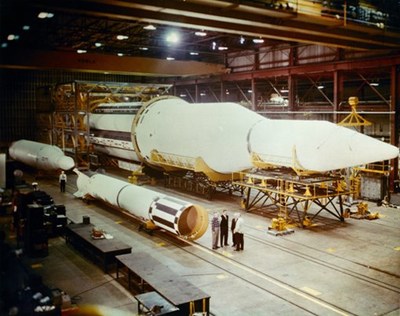 In the foreground is a Redstone MRLV used to launch Mercury on suborbital missions. Tooling and jigs used for the Redstone and the Jupiter IRBM (to the left) propellant tanks were used to construct the cluster of tanks used for the Saturn I first stage seen in the background. (credit: NASA/MSFC) |
Retirement and afterwards
The Redstone, now nicknamed “Old Reliable”, continued to be part of America’s Cold War arsenal until it was declared obsolete on June 25, 1964. Newer missiles, like the solid-propellant Pershing, were much more mobile and easier to prepare for launch in the field than the liquid-fueled Redstone. On October 30, 1964, the US officially retired the Redstone from service during a ceremony at the Redstone Arsenal, and all support contracts were terminated on December 1. The Redstone and its support equipment were subsequently consigned to museums or scrapped in the coming years. But before the last of the Redstones were gone, the Defense Department used it one last time as part of an antiballistic missile test program called Project Defender. On November 30, 1965, a Redstone launched from San Nicholas Island off the California coast and was subsequently intercepted by a Navy Terrier surface-to-air missile.
| WRESAT was the last known launch of the Redstone and a perfect ending to its long successful career in space and as a weapon. |
Before the last of the Redstones were permanently consigned to history, it performed one last mission in 1966. It served as the launch vehicle in the joint United States/United Kingdom/Australia program called Project SPARTA (SPecial Antimissile Research Tests, Australia), which was to observe model warheads of various shapes and materials during reentry. The SPARTA rocket consisted of a Redstone as the first stage, an Antares solid rocket motor (similar to those used in the third stage of NASA’s Scout all-solid launch vehicle) for the second stage and a BE-3 solid motor for the third stage. The rockets launched from the Woomera Test Range in South Australia, with the first two stages lifting the test body to an altitude of about 360 kilometers (224 miles). The third stage would then fire downwards to push the test body back into the atmosphere at speeds of over 6 kilometers per second (3.7 miles per second) to be observed by radar and various optical sensors. TRW Systems Group was the prime contractor, LTV Aerospace Corporation supplied the upper stages, and Chrysler refurbished a total of ten surplus Redstone missiles for the program. In order to launch the SPARTA rocket, some ground equipment donated to the Smithsonian Institution had to be borrowed back.
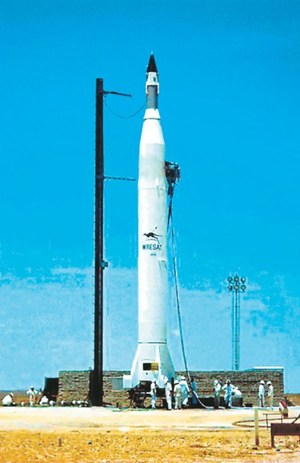 A SPARTA rocket being prepared to launch the Australian WRESAT into orbit from the Woomera Test Range for the last known flight of the Redstone on November 29, 1967. (credit: RAAF) |
The first launch of the SPARTA on November 26, 1966, apparently failed and was destroyed by range safety. The following eight launches, with the last taking place on October 31, 1967, were successful, meeting all Project SPARTA objectives. Australia’s Weapons Research Establishment (WRE) got permission to use the last surplus SPARTA rocket to launch a test satellite they had constructed. Called WRESAT, it was a cone 1.59 meters (5.22 feet) long with a base diameter of 76 centimeters (30 inches) and a mass of 45 kilograms (99 pounds). It carried a payload of ultraviolet and X-ray sensors similar to those Australia had launched earlier on sounding rockets.
WRESAT was launched on November 29, 1967, and entered a 193 by 1,259 kilometer (120 by 782 mile) orbit inclined 82.2 degrees to the Equator. This made Australia only the fourth nation after the Soviet Union, the United States, and France to successfully build and launch a satellite from its own territory. WRESAT continued to transmit data until its batteries were exhausted on December 8 and reentered the Earth’s atmosphere on January 10, 1968. In April of 1990 WRESAT’s Redstone first stage was recovered from Australia’s Simpson Desert and subsequently put on display at the Woomera National Aerospace and Missile Park. This was the last known launch of the Redstone and a perfect ending to its long successful career in space and as a weapon.
Bibliography
David Baker, The Rocket: The History and Development of Rocket & Missile Technology, Crown Publishers, 1978
Bill Gunston, The Illustrated Encyclopedia of the World’s Rockets and Missiles, Salamander Books, 1979
Chuck Hansen, U.S. Nuclear Weapons: The Secret History, Aerofax/Orion Books, 1988
Keith J. Scala and Michael A. Crowe, “SPARTA Program: The Redstone Down Under”, Spaceflight, Vol. 33, No. 8, pp 287–288, August 1991
Keith J. Scala, “The Secret Life of the Redstone Missile”, Quest, Vol. 3, No. 2/3, pp 68–74, Summer/Fall 1994
Wernher von Braun, “The Redstone, Jupiter, and Juno”, in The History of Rocket Technology (ed. Eugene M. Emme), pp 107–121, Wayne State University Press, 1964
